brake VAUXHALL VIVARO 2015.5 Owner's Manual
[x] Cancel search | Manufacturer: VAUXHALL, Model Year: 2015.5, Model line: VIVARO, Model: VAUXHALL VIVARO 2015.5Pages: 203, PDF Size: 4.54 MB
Page 19 of 203
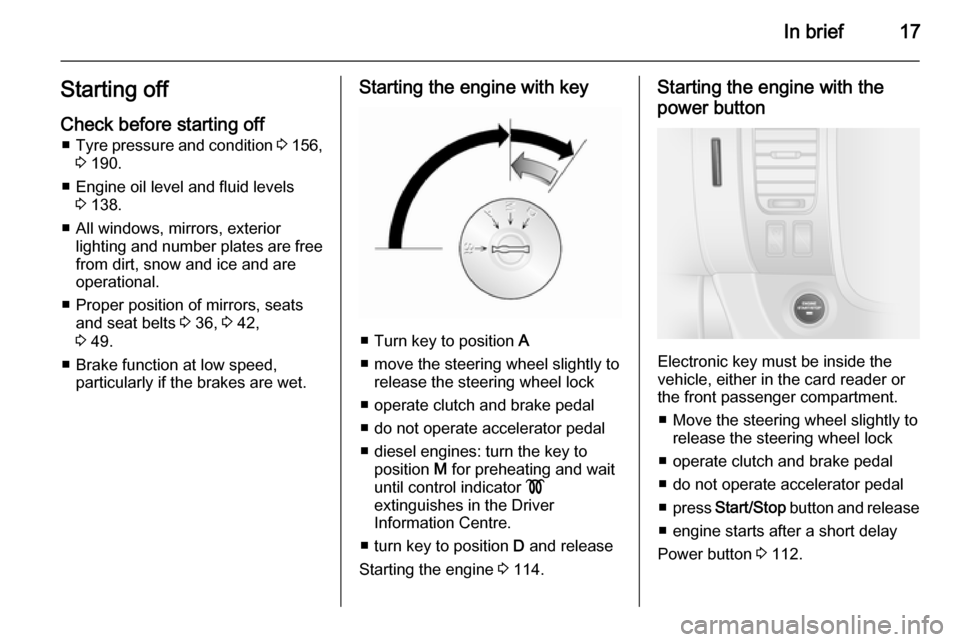
In brief17Starting offCheck before starting off ■ Tyre pressure and condition 3 156,
3 190.
■ Engine oil level and fluid levels 3 138.
■ All windows, mirrors, exterior lighting and number plates are free
from dirt, snow and ice and are
operational.
■ Proper position of mirrors, seats and seat belts 3 36, 3 42,
3 49.
■ Brake function at low speed, particularly if the brakes are wet.Starting the engine with key
■ Turn key to position A
■ move the steering wheel slightly to release the steering wheel lock
■ operate clutch and brake pedal
■ do not operate accelerator pedal
■ diesel engines: turn the key to position M for preheating and wait
until control indicator !
extinguishes in the Driver
Information Centre.
■ turn key to position D and release
Starting the engine 3 114.
Starting the engine with the
power button
Electronic key must be inside the
vehicle, either in the card reader or
the front passenger compartment.
■ Move the steering wheel slightly to release the steering wheel lock
■ operate clutch and brake pedal
■ do not operate accelerator pedal
■ press Start/Stop button and release
■ engine starts after a short delay
Power button 3 112.
Page 20 of 203
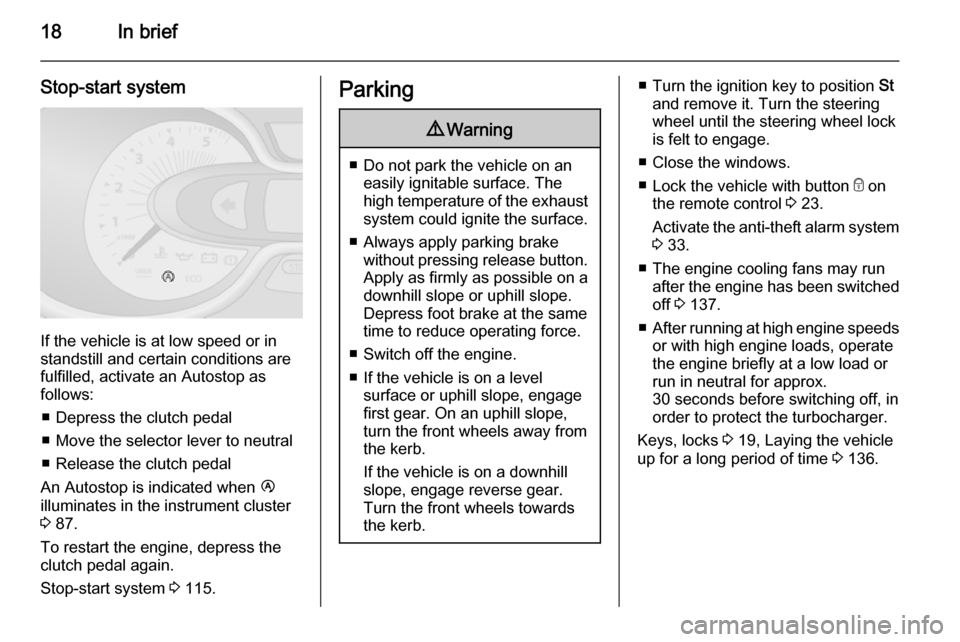
18In brief
Stop-start system
If the vehicle is at low speed or in
standstill and certain conditions are
fulfilled, activate an Autostop as
follows:
■ Depress the clutch pedal
■ Move the selector lever to neutral
■ Release the clutch pedal
An Autostop is indicated when Ï
illuminates in the instrument cluster
3 87.
To restart the engine, depress the
clutch pedal again.
Stop-start system 3 115.
Parking9 Warning
■ Do not park the vehicle on an
easily ignitable surface. The
high temperature of the exhaust system could ignite the surface.
■ Always apply parking brake without pressing release button.Apply as firmly as possible on a
downhill slope or uphill slope.
Depress foot brake at the same
time to reduce operating force.
■ Switch off the engine.
■ If the vehicle is on a level surface or uphill slope, engage
first gear. On an uphill slope,
turn the front wheels away from the kerb.
If the vehicle is on a downhill
slope, engage reverse gear.
Turn the front wheels towards
the kerb.
■ Turn the ignition key to position St
and remove it. Turn the steering wheel until the steering wheel lock
is felt to engage.
■ Close the windows.
■ Lock the vehicle with button e on
the remote control 3 23.
Activate the anti-theft alarm system
3 33.
■ The engine cooling fans may run after the engine has been switchedoff 3 137.
■ After running at high engine speeds
or with high engine loads, operate
the engine briefly at a low load or
run in neutral for approx.
30 seconds before switching off, in
order to protect the turbocharger.
Keys, locks 3 19, Laying the vehicle
up for a long period of time 3 136.
Page 31 of 203
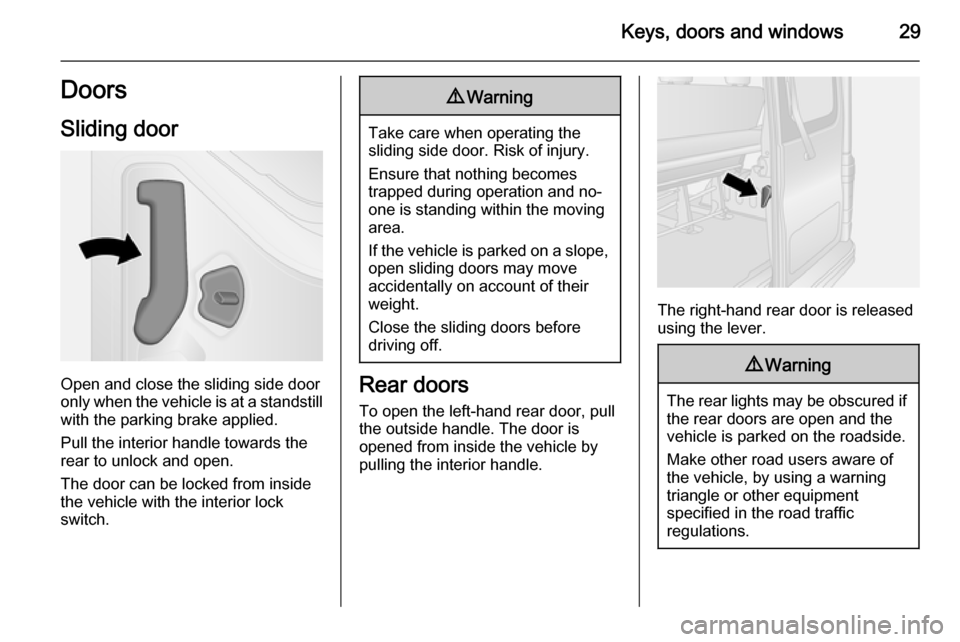
Keys, doors and windows29DoorsSliding door
Open and close the sliding side door
only when the vehicle is at a standstill with the parking brake applied.
Pull the interior handle towards the
rear to unlock and open.
The door can be locked from inside
the vehicle with the interior lock
switch.
9 Warning
Take care when operating the
sliding side door. Risk of injury.
Ensure that nothing becomes
trapped during operation and no-
one is standing within the moving
area.
If the vehicle is parked on a slope,
open sliding doors may move
accidentally on account of their
weight.
Close the sliding doors before
driving off.
Rear doors
To open the left-hand rear door, pull
the outside handle. The door is
opened from inside the vehicle by
pulling the interior handle.
The right-hand rear door is released
using the lever.
9 Warning
The rear lights may be obscured if
the rear doors are open and the
vehicle is parked on the roadside.
Make other road users aware of the vehicle, by using a warning
triangle or other equipment
specified in the road traffic
regulations.
Page 73 of 203

Storage71Roof rack system
Roof rack For safety reasons and to avoiddamage to the roof, the vehicle
approved roof rack system is
recommended.
Follow the installation instructions and remove the roof rack when not in
use.
Further information 3 71.Loading information
■ Heavy objects in the load compartment should be evenlydistributed and placed as far
forward as possible. If objects can
be stacked, the heavier objects
should be placed at the bottom.
■ Secure objects with lashing straps attached to lashing eyes 3 69.
■ Secure loose objects in load compartment to prevent sliding.
■ When transporting objects in the load compartment, the backrests ofthe rear seats must not be angled
forward.
■ Do not allow the load to protrude above the upper edge of the
backrests.
■ Do not place any objects on the instrument panel.
■ The load must not obstruct the operation of the pedals, parking
brake and gear selector, or hinder
the freedom of movement of the
driver. Do not place any unsecured
objects in the interior.■ Do not drive with an open load compartment. In addition, the
number plate is only
distinguishable and illuminated correctly if the doors are closed.9 Warning
Always make sure that the load in
the vehicle is securely stowed.
Otherwise objects can be thrown
around inside the vehicle and
cause personal injury or damage
to the load or car.
■ The payload is the difference between the permitted gross
vehicle weight (see identification
plate 3 177) and the EC kerb
weight.
To calculate the payload, enter the
data for your vehicle in the Weights
table at the front of this manual.
The EC kerb weight includes
weights for the driver (68 kg),
luggage (7 kg) and all fluids (tank
90 % full).
Page 86 of 203
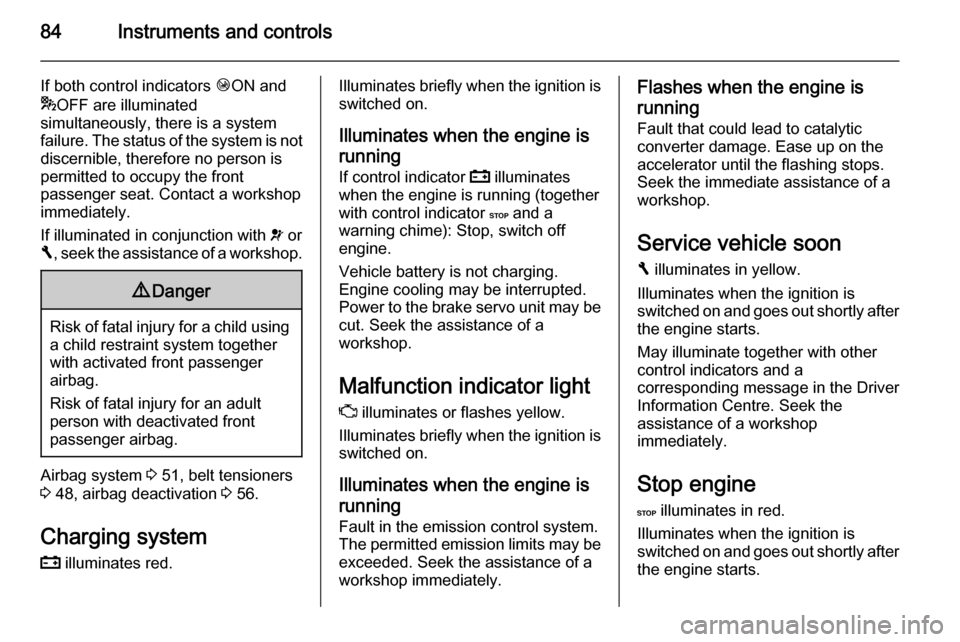
84Instruments and controls
If both control indicators ÓON and
* OFF are illuminated
simultaneously, there is a system
failure. The status of the system is not discernible, therefore no person is
permitted to occupy the front
passenger seat. Contact a workshop immediately.
If illuminated in conjunction with v or
F , seek the assistance of a workshop.9 Danger
Risk of fatal injury for a child using
a child restraint system together
with activated front passenger
airbag.
Risk of fatal injury for an adult
person with deactivated front
passenger airbag.
Airbag system 3 51, belt tensioners
3 48, airbag deactivation 3 56.
Charging system p illuminates red.
Illuminates briefly when the ignition is
switched on.
Illuminates when the engine is
running
If control indicator p illuminates
when the engine is running (together
with control indicator C and a
warning chime): Stop, switch off
engine.
Vehicle battery is not charging.
Engine cooling may be interrupted.
Power to the brake servo unit may be
cut. Seek the assistance of a
workshop.
Malfunction indicator light Z illuminates or flashes yellow.
Illuminates briefly when the ignition is
switched on.
Illuminates when the engine is running Fault in the emission control system.
The permitted emission limits may be
exceeded. Seek the assistance of a
workshop immediately.Flashes when the engine is
running
Fault that could lead to catalytic
converter damage. Ease up on the
accelerator until the flashing stops.
Seek the immediate assistance of a
workshop.
Service vehicle soon F illuminates in yellow.
Illuminates when the ignition is
switched on and goes out shortly after
the engine starts.
May illuminate together with other
control indicators and a
corresponding message in the Driver
Information Centre. Seek the
assistance of a workshop
immediately.
Stop engine C illuminates in red.
Illuminates when the ignition is
switched on and goes out shortly after
the engine starts.
Page 87 of 203

Instruments and controls85
Illuminates together with other controlindicators (e.g., p, I and R),
accompanied by a warning chime and
a corresponding message in the
Driver Information Centre: stop
engine immediately and seek the
assistance of a workshop.
Brake system
R illuminates red.
Illuminates when the parking brake is
released if the brake fluid level is too
low 3 142.9 Warning
Stop. Do not continue your
journey. Consult a workshop.
Illuminates after the ignition is
switched on if the parking brake is
applied 3 121 and extinguishes
when the parking brake is released.
If R illuminates together with control
indicator C and a warning chime,
there is a fault in the braking system.
A corresponding message also
appears in the Driver Information
Centre 3 88. Seek the assistance of
a workshop immediately.
Brake system 3 120.
Antilock brake system
(ABS) u illuminates yellow.
Illuminates briefly after the ignition is
switched on. The system is ready for
operation when u goes out.
If control indicator u does not go out
after a few seconds, or if it illuminates while driving, there is a fault in the
ABS. Control indicator F may also
illuminate in the instrument cluster
together a corresponding message in the Driver Information Centre. The
brake system remains operational but without ABS regulation.
If control indicators u, F , R and C
illuminate, there is a fault in the
braking system. A corresponding
message appears in the Driver
Information Centre 3 88. Seek the
assistance of a workshop
immediately.Antilock brake system 3 120.
Upshift
k or j illuminates.
It is recommended to shift gear when
illuminated to improve fuel economy.
Electronic Stability
Program
v flashes or illuminates yellow.
Illuminates briefly when the ignition is
switched on.
Flashing during driving The system is actively engaged.
Engine output may be reduced and
the vehicle may be braked
automatically to a small degree.
Illuminates while driving
The system is not available. A
corresponding message also
appears in the Driver Information
Centre.
ESP® Plus
3 123, Traction Control
system 3 122.
Page 89 of 203

Instruments and controls87
3. Move out of the flow of traffic asquickly as possible without
impeding other vehicles.
4. Switch off ignition.9 Warning
When the engine is off,
considerably more force is needed
to brake and steer.
Do not remove key until vehicle is stationary, otherwise the steering
wheel lock could engage
unexpectedly.
Check oil level before seeking
assistance of a workshop 3 138.
Fuel economy mode
ECO illuminates green when ECO
mode is engaged to reduce fuel
consumption.
ECO mode, driving economically
3 110.
Low fuel
Y illuminates yellow.
When the ignition is switched on, the control indicator illuminates briefly.
Illuminates when level in fuel tank is
low (range of approx. 30 miles); refuel
immediately 3 132.
Catalytic converter 3 118.
Bleeding the diesel fuel system
3 144.
Autostop
D illuminates when engine is in an
Autostop.
Stop-start system 3 115.
Exterior light
9 illuminates green.
Illuminated when the headlights are on.
8 illuminates green.
Illuminated when the sidelights are
on.
Lighting 3 93.High beam
P illuminates blue.
Illuminated when high beam is on and during headlight flash 3 94.
Fog light > illuminates green.
Illuminated when the front fog lights
are on 3 96.
Rear fog light
r illuminates green.
Illuminated when the rear fog light is
on 3 96.
Cruise control
m , U illuminates green or yellow.
m illuminates green when a certain
speed is stored.
U illuminates green when the system
is on.
Speed limiter
U illuminates yellow.
Page 91 of 203

Instruments and controls89Vehicle messages
Messages are displayed in the Driver
Information Centre and may be
accompanied by illumination of
control indicator F or C in the
instrument cluster.
Information messages Information messages regarding,
e.g. engine starting conditions, stop-
start system, parking brake
application, central locking, steering
wheel lock etc. provide the current
status of certain vehicle functions and
instructions for use.
Fault messages Fault messages regarding, e.g. fuel
filter, airbags, exhaust emissions etc.
are displayed together with control
indicator F. Drive with caution and
seek the assistance of a workshop as
soon as possible.
To remove fault messages from the
display, press button on end of wiper
lever. After a few seconds the
message may disappearautomatically and F remains
illuminated. The fault will then be
stored in the on board system.
Warning messagesWarning messages regarding, e.g.
engine, battery or brake system
failure, are displayed together with
control indicator C and may be
accompanied by a warning chime.
Stop engine immediately and seek
the assistance of a workshop.
Fuel economy messages
Fuel economy messages provide tips to improve fuel efficiency. Journeys
can be saved in the system memory,
enabling you to compare
performances.
Refer to Infotainment system manual
for further information.
Fuel economy rating 3 90.
Warning chimes
A corresponding message may also
appear in the Driver Information
Centre when a warning chime is
sounded.When starting the engine or
whilst driving: ■ If seat belt is not fastened 3 48.
■ During operation of the turn and lane-change signals 3 95.
■ During illumination of certain control indicators.
■ If the parking assist detects an object 3 128.
■ If the vehicle speed briefly exceeds
a set limit 3 124, 3 128.
■ If a door or the bonnet is not properly closed when vehicle
exceeds a certain speed.
■ If there is a fault in the brake system
3 85.
■ If the vehicle battery is not charging
3 84.
■ If engine lubrication is interrupted 3 86.
■ If the electronic key is outside of the
detection range.
Electronic key system 3 21, Power
button 3 112.
Page 112 of 203
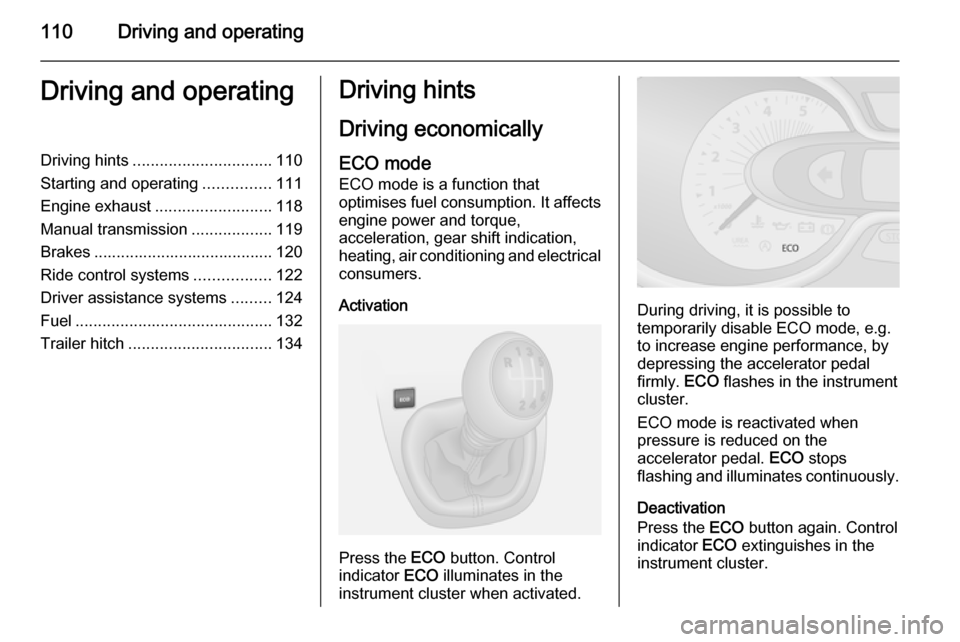
110Driving and operatingDriving and operatingDriving hints............................... 110
Starting and operating ...............111
Engine exhaust .......................... 118
Manual transmission ..................119
Brakes ........................................ 120
Ride control systems .................122
Driver assistance systems .........124
Fuel ............................................ 132
Trailer hitch ................................ 134Driving hints
Driving economically ECO mode
ECO mode is a function that
optimises fuel consumption. It affects engine power and torque,
acceleration, gear shift indication,
heating, air conditioning and electrical consumers.
Activation
Press the ECO button. Control
indicator ECO illuminates in the
instrument cluster when activated.
During driving, it is possible to
temporarily disable ECO mode, e.g.
to increase engine performance, by
depressing the accelerator pedal
firmly. ECO flashes in the instrument
cluster.
ECO mode is reactivated when
pressure is reduced on the
accelerator pedal. ECO stops
flashing and illuminates continuously.
Deactivation
Press the ECO button again. Control
indicator ECO extinguishes in the
instrument cluster.
Page 113 of 203
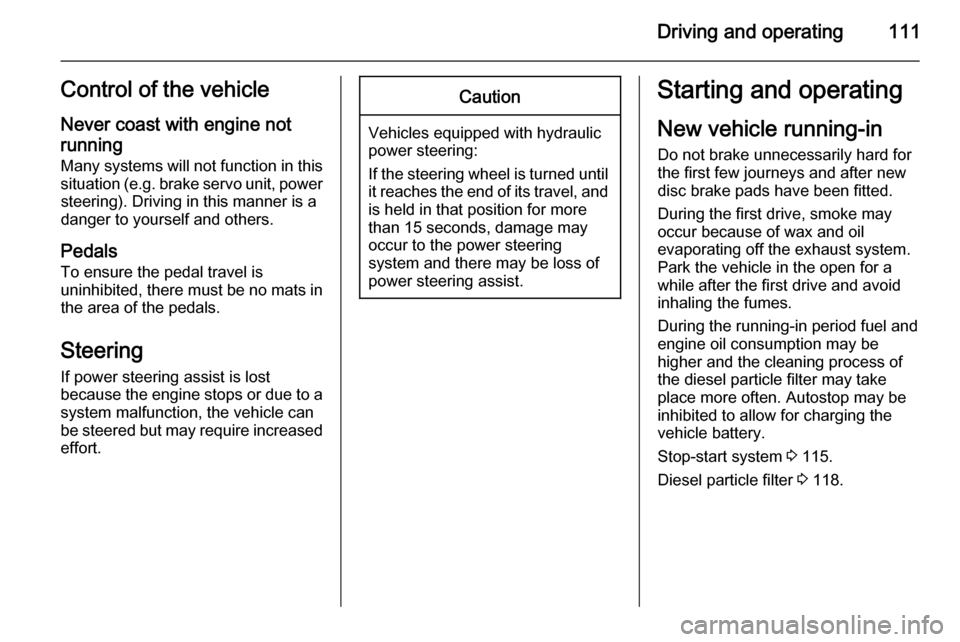
Driving and operating111Control of the vehicleNever coast with engine not
running
Many systems will not function in this
situation ( e.g. brake servo unit, power
steering). Driving in this manner is a
danger to yourself and others.
Pedals To ensure the pedal travel is
uninhibited, there must be no mats in the area of the pedals.
Steering If power steering assist is lost
because the engine stops or due to a
system malfunction, the vehicle can
be steered but may require increased
effort.Caution
Vehicles equipped with hydraulic
power steering:
If the steering wheel is turned until it reaches the end of its travel, and
is held in that position for more
than 15 seconds, damage may
occur to the power steering
system and there may be loss of
power steering assist.
Starting and operating
New vehicle running-in Do not brake unnecessarily hard for
the first few journeys and after new
disc brake pads have been fitted.
During the first drive, smoke may
occur because of wax and oil
evaporating off the exhaust system.
Park the vehicle in the open for a
while after the first drive and avoid
inhaling the fumes.
During the running-in period fuel and
engine oil consumption may be
higher and the cleaning process of the diesel particle filter may take
place more often. Autostop may be inhibited to allow for charging the
vehicle battery.
Stop-start system 3 115.
Diesel particle filter 3 118.